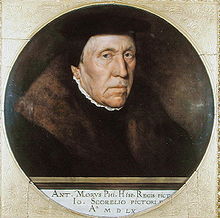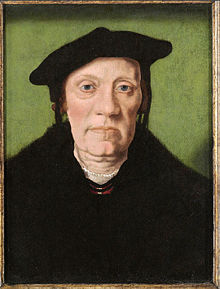Jan van Scorel



Jan van Scorel (1 August 1495 – 6 December 1562[1]) was a Dutch painter, who played a leading role in introducing aspects of Italian Renaissance painting into Dutch and Flemish Renaissance painting. He was one of the early painters of the Romanist style who had spent a number of years in Italy, where he thoroughly absorbed the Italian style of painting. His trip to Italy coincided with the brief reign of the only Dutch pope in history, Adrian VI in 1522–23. The pope made him a court painter and superintendent of his collection of antiquities. His stay in Italy lasted from 1518 to 1524 and he also visited Nuremberg, Venice and Jerusalem. Venetian art had an important impact on the development of his style.[2]
He differed from most Romanists in that he was a native of the northern Netherlands and not of
Biography

Van Scorel was born in
In 1524 Jan Gossaert is recorded at Duurstede Castle, near Utrecht, where Jan van Scorel was his pupil.[4] Van Scorel began traveling through Europe in his early twenties after visiting Utrecht. In 1518–22 he is registered in Venice,[1] and along the way, heading to Nuremberg and then on via Austria over the Alps. In the village of Obervellach in 1520, he completed his first representative work, the "Frangipani-Altar" in St. Martin's church. Giorgione was a considerable influence on Van Scorel during his tenure in Venice. After leaving Venice,[1] Van Scorel was in Rome from 1522 to 1524 and made a pilgrimage to the Holy Land. His experiences in Jerusalem are depicted in many of his later works. Perhaps Van Scorel's example encouraged Van Heemskerck to travel to Rome himself later.
In 1521, Van Scorel returned to Rome where he met the Dutch pope
Upon his return to the Netherlands in 1524, he settled in Utrecht

Considered to be the leading
Influences
Contemporary painters that Van Scorel may have met, taught, and/or collaborated with, are
Public collections
- Centraal Museum, Utrecht
- Museum Catharijneconvent, Utrecht
- Museum Boijmans Van Beuningen, Rotterdam[6]
- Rijksmuseum Amsterdam[7]
References
- ^ a b c d e f g Jan van Scorel record at the RKD
- ^ Snyder, 467–469
- ^ Snyder, 469–473
- ^ Jan Gossaert record at the RKD
- ^ Map by Van Scorel in Ziper museum
- ^ Collection Museum Boijmans Van Beuningen
- ^ Collection Rijksmuseum
External links
 Media related to Jan van Scorel at Wikimedia Commons
Media related to Jan van Scorel at Wikimedia Commons- Short biography
- Guide to pictures on-line
- Literature on Jan van Scorel
